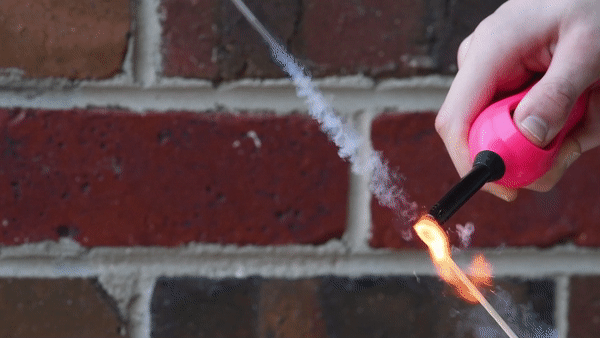Create a simple but powerful match-head rocket, demonstrating Newton’s third law of motion.
Caution: matches! Fire! Eyes! Adult supervision definitely needed for this one.
What you need:
Wooden matches, aluminium foil, paper towel, wooden skewers, needle-nose pliers and wire cutters, tape (duct tape or electrical tape)
What to do:
To cut out the shape from the aluminium foil: Place a paper towel on the aluminium foil. Fold the foil and towel together until it is 4-8 sheets thick. Cut a shape like this:

Separate the foil pieces from the paper towel pieces.
Cut the match heads off the matches using the wire cutters.
Cut the sharp tip off a skewer.
Start to roll the foil shape onto the skewer, to curl the end a little, then unroll again. Place the match head into the groove created by curling the end of the foil shape, around 5 mm from the corner, and place the skewer below it. Then start rolling the foil onto the skewer again. After a couple turns, fold a corner of the foil over the match head, and continue rolling. When finished, crimp the end of the foil shape the sticks out beyond the match head, and fold it over a couple times, then crimp it again to make the end pointed.
For the rocket fins, cut a square of tape. Poke a hole in the centre with another skewer. Place over the head of the rocket and slide it down onto the rocket body. Fold and pinch the tape towards each corner of the square to make four rocket fins. You can trim the fins a bit with scissors if there is excess tape.
You can carefully remove your rocket from the skewer once it is done, and use the skewer to make more rockets.
To launch your rocket: place the rocket back on the skewer, and place the skewer in a block of Styrofoam or in a hole in a cardboard box, or a bottle or some other stand. Hold a lit match, candle, or lighter near the head of the rocket.
What happens;
When the match inside the head of the rocket gets hot enough, it starts to burn. The burning match creates hot gas which creates pressure inside the body of the rocket. The pressure of the gas on the rocket pushes the rocket forward, and the reaction force of the rocket on the gas pushes the gas out of the back of the rocket. Conservation of momentum says that the backwards momentum of the gas out of the rocket is equal to the forwards momentum of the rocket.
Back to Home Science activities.
—this homescience experiment written by Michael Fuhrer (FLEET Director)

